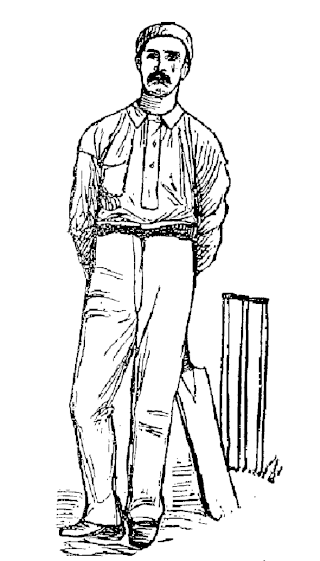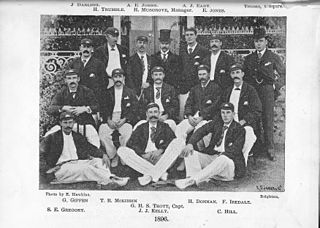Related Research Articles

The Otago cricket team, nicknamed the Volts since the 1997–98 season, are a New Zealand first-class cricket team which first played representative cricket in 1864. The team represents the Otago, Southland and North Otago regions of New Zealand's South Island. Their main governing board is the Otago Cricket Association which is one of six major associations that make up New Zealand Cricket.
This article describes the history of New Zealand cricket to 1890.

The Australia national cricket team toured England in 1882. The team is officially termed the Third Australians, following two previous tours in the 1878 and 1880 seasons. At the time, there was no Test cricket and so, as in 1880, the single match between England and Australia was rated first-class only. It has since been retrospectively recognised as a Test match. It also became historically famous as the match which created The Ashes.

The Australia national cricket team toured England in 1884. The team is officially termed the Fourth Australians, following three previous tours in the 1878, 1880 and 1882 seasons. The 1884 tour was a private venture by the thirteen players who each invested an agreed sum to provide funding, none of Australia's colonial cricket associations being involved. Billy Murdoch captained the team and George Alexander acted as player-manager. The Australians played a total of 32 matches in England, 31 of which have first-class status.
During the 1882–83 New Zealand cricket season, the first class cricket consisted of six matches: an Auckland team went on a tour in December including three games, two in the South Island and in Wellington on the southern tip of the North Island, and three further local clashes.

An English team raised by the Marylebone Cricket Club (MCC) toured New Zealand between December 1906 and March 1907. The tour comprised two first-class matches against New Zealand, two each against the four main provincial teams – Auckland, Canterbury, Otago and Wellington – and one against Hawke's Bay. There were also five minor matches against teams from country areas.

Kenneth Frank McNeill Uttley was a New Zealand cricketer and pathologist.

William Edward Barton was a New Zealand cricketer who played ten first-class matches for West Coast and Auckland in the 1880s. During his career he was widely considered to be the best batsman in New Zealand.

An Australian team toured New Zealand and Fiji from February to April 1905 to play four first-class matches including two against New Zealand, which had not then attained Test status. Although it was the fifth Australian team to tour New Zealand, it was the first one to play matches on even terms, which therefore have first-class status. On previous tours all matches had been against teams of 15, 18 or 22 players. As well as the two matches against New Zealand, the Australians played first-class matches against Canterbury and Otago. The other games were non-first-class against Auckland, Wellington and Fiji.
The Australia national cricket team toured New Zealand from February to April 1914 and played eight first-class matches including two against the New Zealand national team. New Zealand at this time had not been elevated to Test status. The tour was organized and captained by Arthur Sims, who had previously represented New Zealand. The tour is notable for the fact that it featured Victor Trumper's final appearance in a first-class match before his death at age 37 in 1915.
An Australian cricket team toured New Zealand from February to April 1921 to play nine first-class matches including two against New Zealand. The Australians also played the main provincial teams.
The Australia national cricket team toured New Zealand from February to April 1928 and played six first-class matches including two against the New Zealand national cricket team. This was before New Zealand began playing Test cricket.

Daniel Jason McBeath was a New Zealand cricketer who played first-class cricket between the 1917–18 and 1926–27 seasons. He was born at Malvern in the Canterbury Region in 1897.
Gordon Innes Millington was an English-born New Zealand cricketer and farmer. He played two first-class matches for Otago, one in each of the 1876–77 and 1880–81 seasons.
Carl Zimmerman was a New Zealand sportsman. He played nine first-class cricket matches for Otago between the 1925–26 and 1929–30 seasons, represented the Canterbury Rugby Union and played competitive squash. He lived most of his adult life in Oamaru, working first as a teacher, then as a lawyer.

Daniel Joseph Francis Lynch was a New Zealand cricketer. He played nine first-class matches for Auckland between 1877 and 1890.
The Australian cricket team toured New Zealand in January and February 1878, before their 1878 tour of England. It was the first overseas tour by a representative Australian team.
The Australian cricket team toured New Zealand in late November and early December 1886.

The Australian cricket team toured New Zealand in November 1896, playing five matches. They were returning from their 1896 tour of England.
The New Zealand Under-23 cricket team played 12 matches of first-class cricket in New Zealand between the 1962–63 season and the 1980–81 season.
References
- 1 2 "The Australian Eleven". Otago Daily Times (5910): 2. 18 January 1881. Retrieved 15 January 2018.
- ↑ "Australian Eleven v. Invercargill Twenty-Two". Southland Times (3923): 2. 18 January 1881. Retrieved 15 January 2018.
- ↑ "Southland v Australians 1880-81". CricketArchive. Retrieved 15 January 2018.
- 1 2 "The Australians in New Zealand". Star (3983): 3. 25 January 1881. Retrieved 15 January 2018.
- ↑ "Otago v Australians 1880-81". CricketArchive. Retrieved 15 January 2018.
- ↑ "Oamaru v Australians 1880-81". CricketArchive. Retrieved 15 January 2018.
- ↑ "Australian Eleven v. Oamaru Twenty-Two". North Otago Times: 2. 26 January 1881. Retrieved 15 January 2018.
- ↑ "The Australians at Timaru". Ashburton Guardian: 2. 26 January 1881.
- ↑ "The Australian Eleven". Timaru Herald: 2. 26 January 1881.
- ↑ "South Canterbury v Australians 1880-81". CricketArchive. Retrieved 2 May 2019.
- ↑ Nigel Smith, Kiwis Declare, Random House, Auckland, 1994, p. 20.
- ↑ "Canterbury v Australians 1880-81". CricketArchive. Retrieved 2 May 2019.
- ↑ "Wellington v Australians 1880-81". CricketArchive. Retrieved 2 May 2019.
- ↑ "The Australian cricket match". Colonist: 3. 10 February 1881.
- ↑ "Nelson v Australians 1880-81". CricketArchive. Retrieved 2 May 2019.
- 1 2 3 "Wanganui v Australians 1880-81". CricketArchive. Retrieved 15 January 2018.
- ↑ R.T. Brittenden, Great Days in New Zealand Cricket, A.H. & A.W. Reed, Wellington, 1958, p. 21.
- ↑ "Obituary", The Cricketer , 17 July 1943, p. 192.
- ↑ "Hawke's Bay v Australians 1880-81". CricketArchive. Retrieved 2 May 2019.
- ↑ "Auckland v Australians 1880-81". CricketArchive. Retrieved 2 May 2019.
- ↑ Don Neely & Richard Payne, Men in White: The History of New Zealand International Cricket, 1894–1985, Moa, Auckland, 1986, p. 30.
- ↑ "The Australians in New Zealand". Evening Star: 5. 24 February 1881.